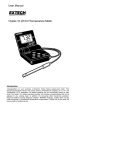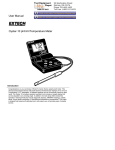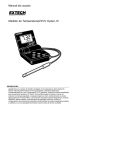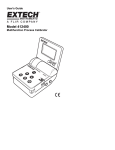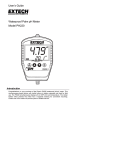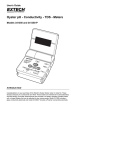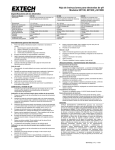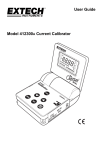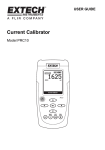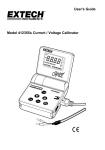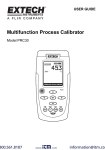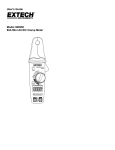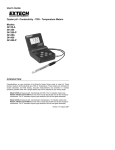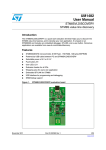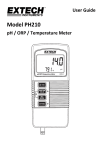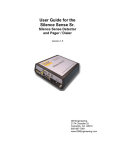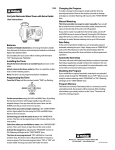Download Extech OYSTER-10 pH/mV/Temperature Meter
Transcript
User Manual Oyster-10 pH/mV/Temperature Meter Introduction Congratulations on your purchase of Extech's Oyster Series splash-proof meter. This microprocessor-based device with tactile buttons simultaneously displays pH or mV and o o Temperature ( C/ F selectable). 25 labeled readings can be conveniently stored for later recall. The Oyster 10 is battery operated, portable, and includes a hinged display that can be adjusted to any viewing angle. In addition, the neck-strap offers hands-free operation. Advanced features include diagnostic displays, MIN/MAX readings, audible alerts, 5-point buffer recognition, & Auto/Manual temperature compensation. This meter is shipped fully tested and calibrated and, with proper use, will provide years of reliable service. Specifications Range (Resolution) ± 1000 mV DC (1 mV) mV o Temperature Accuracy + 2mV o o o 32.0 to 212.0 F (0.0 to 99.9 C) + 0.8 F (0.5 C) 0.00 to 14.00pH (0.01pH) + 0.02pH pH o o Temperature Compensation 32 to 212 F (0-100 C) AUTO or MANUAL modes Power 9 volt battery or optional AC adapter Display Dual LCD display for simultaneous pH or mV and o o temperature readings. LCD viewing angle: 90 to 180 Over-range Indication Displays " ---- " Power 9 volt battery or optional AC adapter Auto Power OFF After 10 minutes of inactivity Low Battery Indication Battery icon appears on LCD Operating Temperature 41ºF to 104ºF (5ºC to 40ºC) Storage Temperature - 4 F to 140 F (-20 C to 60 C) Operating Humidity Max 80% up to 87ºF (31ºC) decreasing linearly to 50% at 104ºF (40ºC) o o o o Storage Humidity <80% Operating Altitude 7000ft. (2000meters) maximum Dimensions / Weight 3.75 x 4.25 x 2" (96 x 108 x 45mm) / 12 oz (340g) Meter Description 1. LCD Display 2. Battery compartment (9V battery) 3. Function buttons (Power, Up/Down, Max/Min, pH/mV, Store/Recall) 4. AC Adapter input (117VAC) 5. RTD Temperature probe input (3.5mm phono jack) 6. BNC style pH/mV electrode input 7. Neckstrap loop (2) 2 4 5 1 6 3 7 2 Oyster-10, V1.9 11/09 pH Overview pH is a unit of measure (ranging from 0 to 14pH) indicating the degree of acidity or alkalinity of a solution. pH tests are the most commonly performed measurements in water analysis, using the hydrogen ion activity of a solution to determine acidity or alkalinity. Solutions with a pH less than 7 are considered acidic, solutions with a pH higher than 7 are known as bases, and solutions with a pH of exactly 7 are considered neutral. The pH scale is logarithmic, so, for example, if sample A is 1 pH less than Sample B, this means that Sample A is 10 times more acidic then Sample B. A difference of 1 pH represents a ten-fold difference in acidity. ORP/REDOX Overview ORP stands for Oxidation Reduction Potential and represents the oxidizing or reducing nature of a solution. The overall “reactive” tendency of a solution can be determined from ORP measurements. ORP testing is becoming more common in waste-water and water treatment measurement regimens. The unit of measurement for ORP is mV. Calibration and Operation pH Calibration (NOTE: ORP does not require calibration) Before accurate measurements can be obtained, it is necessary to calibrate the meter with the electrode. Typically, pH 7 is calibrated first and then one or more of the other buffers (shown in the left column in the table below). The meter automatically recognizes all of the buffers listed in the table below and calibrates itself to the buffer’s pH value. 1. Connect the pH electrode to the meter’s BNC connector input. 2. Open the top half of the meter to an appropriate viewing position. 3. Power the meter with the POWER/CAL button. 4. Place the electrode into a buffer solution (4, 7, or 10). 5. Press and hold the CAL key until the CAL display icon appears. 6. During calibration, CAL is shown on the display followed by SA (saved). 7. When calibration is complete, the meter automatically displays END and returns to normal operation mode. Repeat steps 1-5 as necessary. Note that it is not necessary to turn the meter off and then back on again to calibration another reference. Important calibration note: Since pH electrodes can vary in performance, this meter includes a special feature that displays an electrode’s slope in %. For example, if two electrodes (one new and moderately used) are calibrated in the same pH 4 solution they’ll both display pH 4 on the meter. This is because the meter will accept one pH value for a range of measurement values as shown in the table below (in this case, any reading between 1.68pH and 6.50pH will be accepted as 4pH calibration). The meter then displays the slope % for the electrode under test. If the slope % is below 75% or above 125%, the electrode must be replaced. A slope of 100% is ideal. pH reading Range of measurement 1.68 0.00 to 1.68 4.00 1.68 to 6.50 7.00 6.50 to 7.50 10.00 7.50 to 12.45 12.45 12.45 to 14.00 3 Oyster-10, V1.9 11/09 pH Measurement and Temperature Compensation 1. Use the pH/mV button to select the pH mode. The unit of measure appears on the LCD. 2. Connect the pH electrode to the meter and place the sensor end in the solution under test. 3. For automatic temperature compensation, connect the temperature probe to the meter (display will read ATC) and place the sensor end in the solution about 1/3 of the way below the solution surface. The temperature reading of the solution appears on the bottom of the LCD. When the temperature of a sample differs from a buffer solution temperature, allow enough time for the electrode to stabilize to the sample's temperature. 4. For manual temperature compensation, a temperature sensor is not connected to the meter (MANUAL is displayed). Adjust the meter’s temperature display with the up/down buttons so that the displayed temperature matches the temperature of the solution. A manual thermometer will be needed to determine the solution temperature first. 5. To change the unit of measure for temperature (C to F or F to C), press and hold the pH/mV button while powering the meter. The LCD reflects the unit of measure. 6. Read the pH measurement on the main display. An out of range reading is indicated by dashes ( ----- ). 7. When the test is complete, unplug the electrode and rinse it in distilled water. 8. Place approx. 1 ml of pH 4 solution or tap water in the wetting cap before replacing it. mV (ORP) Measurements 1. Note that calibration is not required for mV measurements. 2. Use the pH/mV button to select the mV mode. The display will reflect the unit of measure. 3. Remove the wetting cap from the ORP electrode and connect the cable via the BNC meter connection. 4. Rinse the ORP electrode and place it into a sample solution. When the LCD stabilizes it will read the redox potential of the sample in millivolts. 5. When sampling is complete, unplug and rinse the electrode. Place a small portion (1ml) of distilled water in the wetting cap. Place the cap over the electrode. 25-Reading Measurement Storage 1. Press the STORE/RECALL button to store the current reading. Press each time a reading is to be stored. 2. If an attempt is made to store more than 25 readings, the stored readings (starting with the first reading) will be overwritten. 3. To recall readings, press and hold the STORE/RECALL button until the ‘RECALL’ icon appears on the LCD. Use the up/down arrow buttons to scroll through the stored readings. Note that ‘NULL’ is displayed if there are no readings in memory. 4. To exit this mode, press and hold the STORE/RECALL button until the ‘RECALL’ icon disappears. 5. To clear the contents of the memory press and hold the up and the down arrow buttons while powering the meter on until the ‘CLr’ icon appears on the LCD. All 25 locations will be erased. Note: Readings are stored in non-volatile memory (saved when the meter is turned off). 4 Oyster-10, V1.9 11/09 MAX/MIN Display 1. The meter memorizes the highest (MAX) and lowest (MIN) readings when prompted. 2. Press and hold the MAX/MIN button until both the MAX and MIN icons appear on the LCD. The meter will now begin keeping track of the MIN and MAX readings. 3. To view MAX/MIN values, press the MAX/MIN button again; the meter automatically displays the highest and lowest readings in succession and then returns to the MAX/MIN recording mode. 4. To exit the MAX/MIN mode, press and hold the MAX/MIN button until the MAX and MIN icons disappear. 5. To clear the MAX/MIN memory, cycle the meter power. External Temperature Offset Adjustment The Offset Adjustment is used to fine tune the temperature reading of the external temperature probe. This procedure is for the external probe only when ATC is active. 1. Place the temperature probe into a known temperature and note any temperature reading error. 2. Simultaneously Press and Release the ▲and ▼buttons, 0.0 will appear on the LCD temperature reading 3. .Press the ▲ or ▼ button to set the display equal to the error value determined in step 1. 4. Press the STORE button to save the offset value into memory, 5. Test the temperature probe in the know temperature source to verify the correction was proper and the adjustment made in the correct direction. 5 Oyster-10, V1.9 11/09 pH Electrode Model 60120B Operation The Following information applies to the Epoxy Body, Sealed Reference Combination pH Electrode Model 60120B. Electrode Considerations 1. The 60120B pH electrode is recessed in the polymer body allowing it to rest against the bottom of a beaker without damaging the glass bulb. This eliminates the need for electrode holders and allows the probe to be used as a stirring rod. This sealed reference design eliminates the need for adding filling solutions (minimizing "dry-out") and can be used in up to 100 psig systems without external pressurization. 2. The Electrode should remain in its bottle or cap until used. 3. If bubbles are seen in the bulb area, hold the electrode by its cap and shake downwards until bubbles disappear. 4. To improve speed of response, vigorously stir the electrode in the sample, buffer, or rinse solution. 5. After exposure to a sample, buffer, or rinse solution, shake the electrode with a snap motion to remove residual drops of solution. 6. Use part of the sample/buffer to be tested next as a rinse solution whenever possible. 7. When calibrating, use a buffer as close as possible to the expected pH of the sample. 8. Keep buffers and samples at the same temperature to avoid temperature effects. 9. pH readings stabilize at various rates; allow time for readings to stabilize. 10. Electrodes deteriorate over time. If accuracy falls to 10% (slope), the electrode should be cleaned. If no improvement is observed, replace the electrode. Electrode Calibration and Cleaning Refer to the earlier section ‘Calibration and Operation’ for calibration details. Refer to the section below ‘Maintenance and Troubleshooting’ for details on electrode cleaning. Electrode Storage The electrode can be stored in the soaker bottle or wetting cap. For the storage bottle, slide the cover onto the electrode, replace the O-ring, and insert electrode into the bottle firmly tightening the cap. Ensure that the bottle or cap is filled with a pH of 4 buffer solution. 6 Oyster-10, V1.9 11/09 Maintenance and Troubleshooting Electrode Cleaning The type of electrode coating that occurs over time will determine the cleaning method. Soft coatings can be removed by vigorous stirring or by using a squirt bottle. Organic chemical coating (hard coatings) should be chemically removed. Only in extreme cases should the bulb be cleaned mechanically. Battery Replacement Install a new battery when the low battery indicator appears on the LCD. Remove the battery cover, install a new 9V battery, and replace the battery cover. Troubleshooting the Meter Meters are the least likely cause of pH measurement problems. To rule out the meter check the following: 1. Check the 9V battery and replace it if necessary. 2. When using the AC adaptor for power, check that the line cord is firmly connected to the meter. 3. Replace the existing electrode connector with optional BNC shorting plug (shorts the ground ring to the center pin of the meter’s BNC jack) and check the following: a) Set the measurement mode to pH. The LCD reading should be stable. b) Adjust the calibration control for an LCD reading of 7.00. c) Change to the mV measurement mode. The LCD should read 0 mV. d) Note that an out of range reading is indicated by dashes ( -------). 7 Oyster-10, V1.9 11/09 Troubleshooting an Electrode Problem Symptom Cause Long response time or Clogged Junction reading drift Strong Alkaline measurement Deteriorated Gel layer of pH sensing membrane Protein coating on electrode surface Dry Bulb Static Charge Same readings in different buffers and samples Erratic LCD display Recommended Solution Soak in 4.07 M Potassium Chloride o (KCl) @ 60 C for 30 minutes. Replace electrode if necessary. Soak in 0.1 M HCL overnight Replace electrode Soak in 1 gm Pepsin dissolved in 100ml of 0.1 m HCL for 30 mins. or as needed Oil, paint, dyes, suspended Rinse electrode alternately with solids on sensor materials solvent (briefly) then a buffer 7.00 Organic solvents are Organic mole fraction has to be less coating sensor than 50% to assure reasonable readings. Limit time of measurement. Keep probe in the 7.0 buffer between readings. Dehydrated membrane Read solution for dry bulb below Long term storage without Soak electrode tip in wetting cap filled wetting with 1ml 7.00 buffer for 24 to 48 hours Wiping electrodes Rinse electrode in 7.0 buffer and blot. Do no wipe electrode. Cracked or broken bulb Replace electrode. Use bulb guard. Avoid plunging electrode to bottom of container and spinning bars. A wetting cap will protect bulb between measurements. Samples have low ionic For each 50 ml of sample add 1 drop strength (lacks salt); e.g. (50uL) of SAT.KCL No alteration in distilled, de-ionized, boiled, pH will occur by inert KCL. lake water (high pressure) 8 Oyster-10, V1.9 11/09 Calibration and Repair Services Extech offers repair and calibration services for the products we sell. Extech also provides NIST certification for most products. Call the Customer Care Department for information on calibration services available for this product. Extech recommends that annual calibrations be performed to verify meter performance and accuracy. Warranty EXTECH INSTRUMENTS CORPORATION warrants this instrument to be free of defects in parts and workmanship for three years from date of shipment (a six month limited warranty applies to sensors and cables). If it should become necessary to return the instrument for service during or beyond the warranty period, contact the Customer Service Department at (781) 890-7440 ext. 210 for authorization or visit our website www.extech.com for contact information. A Return Authorization (RA) number must be issued before any product is returned to Extech. The sender is responsible for shipping charges, freight, insurance and proper packaging to prevent damage in transit. This warranty does not apply to defects resulting from action of the user such as misuse, improper wiring, operation outside of specification, improper maintenance or repair, or unauthorized modification. Extech specifically disclaims any implied warranties or merchantability or fitness for a specific purpose and will not be liable for any direct, indirect, incidental or consequential damages. Extech's total liability is limited to repair or replacement of the product. The warranty set forth above is inclusive and no other warranty, whether written or oral, is expressed or implied. Support line (781) 890-7440 Technical Support: Extension 200; E-mail: [email protected] Repair & Returns: Extension 210; E-mail: [email protected] Product specifications subject to change without notice For the latest version of this User Guide, Software updates, and other up-to-the-minute product information, visit our website: www.extech.com Extech Instruments Corporation, 285 Bear Hill Road, Waltham, MA 02451 ISO9001 Certified Copyright © 2009 Extech Instruments Corporation. All rights reserved including the right of reproduction in whole or in part in any form. 9 Oyster-10, V1.9 11/09









